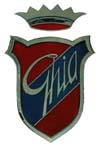



Imperial Home Page -> Literature -> Articles -> The Story of Ghia & Chrysler
|
« back
next »
| |||
|
Virgil M. Exner, Chief Stylist
Luigi Segre's first impressions of the American way of doing things were not very encouraging. Notwithstanding his excellent credentials which gave him an entree into the highest management levels, Segre realised immediately that, amongst the big American motor manufacturers, Chrysler was perhaps the least open to European styling ideas. In those years the marque was synonymous with the petit-bourgeois solidity of the middle classes of the most conservative states; it was a huge market with which the management, curiously consisting for the most part of Texans, was more than satisfied.
As often happens, this decidedly unpromising premise had an unexpected, very positive, development, thanks to a series of favourable circumstances. These were first and foremost of a personal nature: Luigi Segre spoke English rather well, and this certainly contributed towards facilitating relations with the Chrysler men, but the presence in the American group of an fluent Italian speaker, Paul Farago, definitely constituted an important element. Last of all, and perhaps this was the most important element of all, the immediate liking, which later became friendship, between Luigi Segre and Virgil Exner.
Virgil Exner was the virtual head of Chrysler's Advanced Style Centre, which meant of the entire Chrysler Group, including Plymouth, De Soto and Dodge. These were all highly respectable marques with solid, wellestablished products, but they were a long way from the styling requirements which could have justified the setting up of an Advanced Style Centre. Exner naturally suffered as a result of this situation, more so because officially King was the department head. An old, respected stylist, King was on the eve of retirement, and although he gave the younger man plenty of room, he did not however allow him to express all his ideas. Virgil M. Exner was already fifty years old. Ten years before, in his youth, he had been one of the most brilliant designers working with Raymond Loewy, the guru of world design, the man made famous by the Lucky Strike cigarette packet, the Coca-Cola bottle and, in the automotive field, the postwar Studebakers. If it had not been for the fact that in the case of the latter objects, the "real" designer, as often happens in big studios, had been Virgil Exner.
This had caused an argument with Loewy who was loathe to give the slightest recognition to his collaborator: as far as he was concerned the designs were by the Loewy Studio and that was that. Exner was sacked as a result of the disagreement between them, the justification being that while still working for Loewy he had done the styling of some models directly for Studebaker, an unpardonable act even for such a talented designer as he was. The words of Gordon Buehrig, another mythical name in American automotive design, who also worked for the Loewy Studio at the time are revealing: "Exner was an excellent designer and he was convinced that a job well done spoke for itself, on its own merits. Loewy on the other hand, in addition to being a designer was also a promoter, he was as good at designing as he was at selling his studio's product, and so he was absolutely convinced that he could legitimately assume for himself the merits of anyone who worked with him". After leaving the Loewy Studio, Virgil Exner got a job straight away with Studebaker as head of the design department, but the closure of the prestigious old American factory which could boast of having built the wagons of the pioneers who won the West forced him to take a job with Chrysler soon afterwards, where together with his young assistants Cliff Voss and Maury Baldwin he champed at the bit.
In this climate and with these objectives Exner and his team designed the two prototype Chryslers, the K310 and the C200 produced in Turin in 1952. On the other hand, Chrysler's chairman, K. T. Keller had also been favourably impressed by the Ghia prototype Plymouth, although for different reasons. He had realised immediately in fact that it would be impossible to build such a well-finished prototype, for such a low price - when compared to American standards - as Ghia had. He agreed therefore to the building of two of the Exner group's prototypes (the K in K310 stood for Keller) and this was the start of a very important period for both houses.
| |||
| « back Page 2 next » |
This page was last updated 10 January, 2004. Send us your feedback, and come join the Imperial Mailing List - Online Car Club